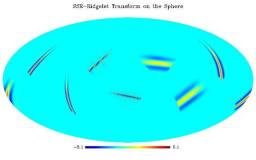In a number of areas of scientific activity, data is gathered which naturally maps to the sphere. For instance, remote sensing of the Earth's surface and atmosphere, generates spherical data maps which are crucial for global and local geophysical studies such as understanding climate change, geodynamics or monitoring human-environment interactions. More examples can be found in medical imaging or computer graphics. In astronomy and astrophysics, recent and upcoming ground based and satellite borne experiments such as WMAP or Planck-Surveyor for the observation of the Cosmic Microwave Background radiation field over the whole celestial sphere, have and will produce full-sky maps in a wide range of wavelengths.
Processing spherical data maps requires specific tools or somehow adapting traditional methods used on flat images to the spherical topology, such as multiscale transforms for image processing. Among these, Wavelets and related representations are by now successfully used in all areas of signal and image processing. Wavelets owe part of their success to their ability for sparse approximation of point singularities. However they are not as good at detecting highly anisotropic features such as curvilinear singularities in images. This is where other multiscale systems such as Ridgelets and Curvelets, which exhibit high directional sensitivity and are highly anisotropic, come into play.
Inspired by the successes of euclidean wavelets, ridgelets and curvelets, the present MRS package provides implementations of new multiscale decompositions for spherical images namely the isotropic undecimated wavelet transform, the ridgelet transform and the curvelet transform each of which is invertible. It also includes implementations of ICA (independent component analysis) techniques for the analysis of multi-channel data mapped to the sphere, namely fastICA, JADE and SMICA and their extensions into the wavelet domain.
This user's guide gives a detailed description of the various tools implemented in the MRS package. The IDL routines available in the package are fully documented. Significant applications and numerical experiments are reported which illustrate the good performance of our toolbox.
In order to use the MRS software package, it is required to have IDL (version 6.0 or later) installed on your computer as well as Healpix . Guidelines for installation are provided in the User's Guide which can be downloaded from the link above.
You can download the MRS package here.
To be kept informed of future releases please subscribe to our mailing list by sending an email to
J.-L Starck, Y. Moudden, P. Abrial and M. Nguyen, "Wavelets, Ridgelets and Curvelets on the Sphere", Astronomy and Astrophysics, vol. 446, 3, 1191-1204, 2006 .
Y. Moudden, J.-F. Cardoso, J.-L. Starck, J. Delabrouille, "Blind Component Separation in Wavelet Space: Application to CMB Analysis", Eurasip Journal on Applied Signal Processing , 2005, 15 pp 2437-2454, 2005.
J. Jin, J.-L. Starck, D.L. Donoho, N. Aghanim and O. Forni, "Cosmological non-Gaussian Signature Detection: Comparing Performance of Different Statistical Tests", Eurasip Journal on Applied Signal Processing , 2005, 15 pp 2470-2485, 2005.
J.-L. Starck, N. Aghanim and O. Forni, "Detecting Cosmological non-Gaussian Signatures by Multi-scale Methods" , Astronomy and Astrophysics , 416, 9-17, 2004.
J. Delabrouille, J.-F. Cardoso and G. Patanchon, "Multi-Detector Multi--Component spectral matching and applications for CMB data analysis", Monthly Notices of the Royal Astronomical Society, 346, 4, 1089-1102, 2003.
S. Pires, J.-B. Juin, D. Yvon, Y. Moudden, S. Anthoine and E. Pierpaoli, "Sunyaev-Zeldovich cluster reconstruction in multiband bolometer camera surveys", submitted to Astronomy and Astrophysics, June 2005.
Send comments, feedback or questions to .
• Structure and evolution of the Universe › Evolution of the large structures and galaxies Structure et évolution de l'Univers
• Department of Astrophysics (DAp) // UMR AIM • The Electronics, Detectors and Computing Division • Le Département d'Astrophysique (DAp) // UMR AIM • Le Département d'Électronique des Détecteurs et d'Informatique pour la Physique (DEDIP)
• Laboratoire d'ingénierie logicielle pour les applications scientifiques (LILAS) • pas de titre


